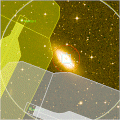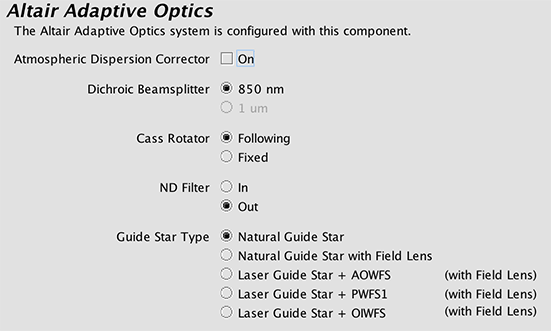
| You are in: Observing Tool (OT) > Science Program > Elements > OT Components and Iterators > OT Altair |
 |
Gemini North Facility Adaptive Optics System (Altair) in the Observing Tool |
This page explains how to configure Altair in the Observing Tool (information on configuring Altair with the laser guide star will be provided shortly):
Refer to the Altair instrument pages for further details of the instrument capabilities.
The detailed component editor for Altair is accessed in the usual manner, by selecting the Altair component in your science program, and is shown below:

Currently this button has no effect as the Atmospheric Dispersion Corrector has been removed from Altair. It was never commissioned.
Currently this button has no effect as there is only one Dichroic Beamsplitter in Altair located at 850 nm. Selecting either button will result in using the 850 nm dichroic.
The Cassegrain Rotator can be set to either "following" or "fixed" mode. The telescope normally operates "following", with the Cassegrain Rotator rotating such that the position angle of the sky stays constant on the detector (usually with North=up and East=left). For Altair, this does not yield an optimal correction. This is because as the cassegrain rotator moves, rotating static aberrations from the primary and secondary mirrors combine non-linearly (i.e. unpredictably) with the fixed aberrations from the instrument path causing (1) decreased Strehls and (2) stellar profiles that vary with the rotator angle. For best correction, set the Cassegrain Rotator to "fixed", which will cause the science field to rotate in the detector, but will give you better AO performance. The orientation of each individual field is recorded in the image header, so you will know where North is on each image for de-rotation and combining the images, but you will not be able to specify this ahead of time. Operating "fixed" is recommended for all imaging applications where field rotation is not critical and a stable, high-Strehl PSF is critical, such as looking for faint companions to bright stars and imaging extended structures.
It is NOT possible for the telescope to have the cassegrain rotator fixed and for you to simultaneously specify the field orientation. Thus, "following" is required for all spectroscopy applications because keeping an object in the slit for a rotating field is not supported.
If you want the Field Lens in the beam and operational, select "In". Otherwise, to operate without the Field Lens, select "Out". In most cases you will want the field lens "In", but all science users should read the detailed Field Lens page. Use of the Field Lens is required with LGS due to the optical design of the LGS system.
The Neutral Density (ND) filter is normally placed in front of the Wavefront Sensor (WFS) for very bright targets. Guide stars brighter than V = 5.5 should use the ND filter always, and the PI should set the button as such. Stars with 5.5 < V < 6.5 may need the ND filter. In this case the PI should leave the ND filter out and place a note in the observation for the observer stating that the ND filter may be needed. For stars fainter than V > 6.5 the ND filter should not be used. Note that the ND filter only affects the WFS in Altair, not the science path, so steps should still be taken with the science instrument to reduce flux if saturation might be an issue. There is currently no ND filter for the LGS WFS (as of 2007A), but a future upgrade may allow it. Any LGS star brighter than R < 10 (such as nearly all telluric calibrators and many photometric calibrators) should be observed with NGS since there is no LGS ND filter.
The save button accepts the latest changes and stores the program to the local database, the undo/redo button (and, transiently, the edit pencil) toggles pending and saved changes and the close button closes the science program editor (saving any changes to the local database).
Last update December 12, 2005; Chad Trujillo